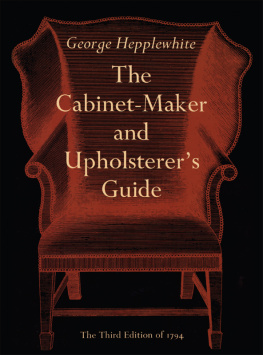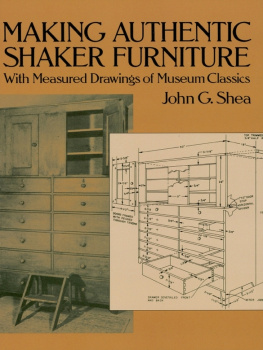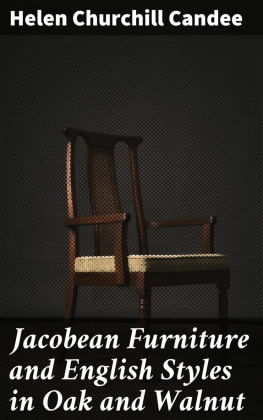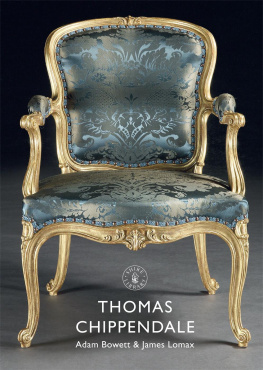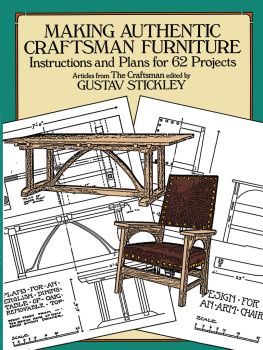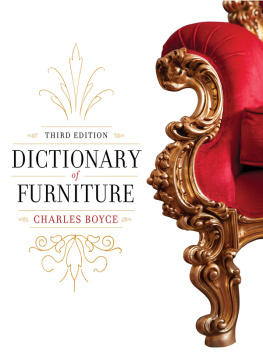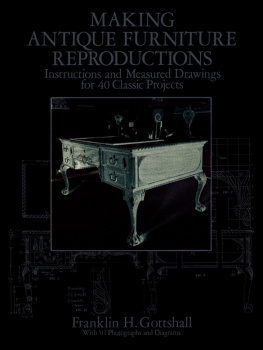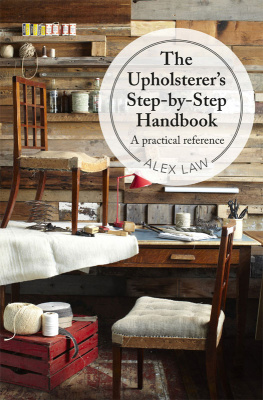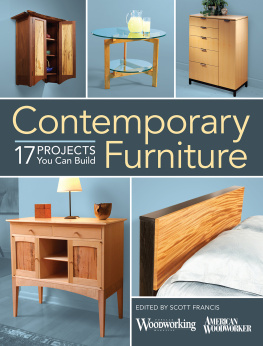THE
CABINET-MAKER
& UPHOLSTERERS
GUIDE
THE
CABINET-MAKER
& UPHOLSTERERS
GUIDE
George Hepplewhite THE THIRD EDITION OF 1794 WITH A NEW INTRODUCTION BY
JOSEPH ARONSON DOVER PUBLICATIONS, INC., NEW YORK Copyright 1969 by Dover Publications, Inc.
All rights reserved. This Dover edition, first published in 1969, is an unabridged and unaltered republication of the third (1794) edition, as published by I. and J. Taylor, London. A new introduction has been written specially for the present edition by Joseph Aronson. Library of Congress Catalog Card Number: 69-19164
International Standard Book Number ISBN-13: 978-0-486-22183-0
ISBN-10: 0-486-22183-0 Manufactured in the United States by Courier Corporation
22183014
www.doverpublications.com
INTRODUCTION TO THE DOVER EDITION
T he sole documented fact presently known about George Hepplewhite is that he died.
This event in 1786 preceded by two years the first appearance of his monument, the publication entitled The Cabinet-Maker and Upholsterers Guide from drawings , over the name of A. Hepplewhite and Co. Cabinet-Makers, and published by I. and J. Taylor, at the Architectural Library, No. 56, Holborn, opposite Great Turn-Stile in London.
The 1788 debut was followed the next year by a slightly revised edition, and in 1794 by the improved third edition which is reproduced here. A. Hepplewhite, the widow Alice, was granted administration of the estate of George Hepplewhite on June 27, 1786. Described as less than 600, this estate could hardly have been the residue of a wildly successful business, compared with the substantial contemporary enterprises of which records survive. Of his business, and of George Hepplewhites personal life, there remains no attributable vestige: no stick of wood, no shred of paper, no bills or letters. The name appears in print only on six plates in a contemporary publication, The Cabinet-Makers London Book of Prices , editions of 1788 and later.
Twenty plates by Thomas Shearer and three by W. Casement which complete this work bear a strong family resemblance, as do all the plates of Shearers Designs for Household Furniture (1788) and, to an extent, even some of Thomas Sheratons examples in his 1791 Drawing Book. The inevitable question is, How did the name of George Hepplewhite come to identify a complete school of furniture design, the style of the whole generation after Chippendales Director ? The broad answer is, of course, that there remains a book illustrating work of the period and bearing Hepplewhites name. The architecture and allied arts of the eighteenth century were effectively memorialized in a significant library of contemporary origin. Three works stand out by reason of their comprehensive scope, the quality of their engravings, the definiteness of their subject matter in delineating a style-period, and their wide distribution at home and abroad. Chippendale, Hepplewhite, and Sheraton are the trisyllabic triad who throughout the nineteenth century were credited with the total furniture output of the Georgian era.
In the early decades of the twentieth century serious researchersConstance Simon, R. S. Clouston, Percy Macquoid, Raiph Edwards, Margaret Jourdain, and Herbert Cescinsky, among otherscompared bills and labels, account books and letters, drawings and actual surviving furniture. Their conclusions, paired with careful reading of texts, and dedicatory remarks in particular, call for a reappraisal of the functions and motivations of the three immortal masters, In short, these men live through their publications rather than through their furniture performances. The Preface to the Hepplewhite work is a treasury of inferences. As modest as it is brief, it neither implies originality nor imputes design invention to Hepplewhite.
It is directed first to the artisan, secondly to the gentleman; it has no list of patrons or subscribers, although such lists were usual in publications of the period. It clearly states its intention of depicting only accepted designs, eschewing mere novelty, whim at the instance of caprice and adhering to such articles only as are of general use and service for the guidance of Foreigners, who seek a knowledge of English taste as well as Cou[n]trymen and Artizans distant from the metropolis. The inference that may be drawn from this is that Widow Alice had the enterprise to make capital of her inheritance of accumulated drawings, sketches, memory-aids, and possibly models, of the late Georges furniture notes and/or ideas. A second inference is that Alice collated the efforts and ideas of contemporaries like Thomas Shearer, whose style is indistinguishable from Hepplewhites. With many more examples extant to judge by, Shearers drawings bespeak, by their very differences, the same hand trying to be different. A conspicuous example is the unsigned , signed Thos.
Shearer del, 1788, in the 1793 edition of The Cabinet-Makers London Book of Prices. Perspective, handles, graining are different, but the concept, parts, and proportions are identical. Speculation is further invited by the differences between the 1788 and the 1794 editions of the Guide , changes that were undoubtedly prompted by the belittling criticism of the Hepplewhite book in Sheratons 1791 Drawing Book. Hepplewhite had certainly mastered the Rococo, absorbing rather than adopting the foreign influence. Cabriole legs, and in fact the whole Louis Quinze vocabulary, appear until almost 1790 in tasteful relation to more Adamesque details; the style is clearly Anglicized, and the transition to Louis Seize influences is gradual and graceful. The cabriole leg is sculpture, not truly rendered in any convention of drawing.
It appears in the first edition of the Guide in various adaptations in chairs and sofas. These pieces are entirely deleted from the 1794 issue, except for two stools, conveys an out-of-date specialized use of the word, which has no relation to cabriole as a leg shape.) Replacing the French-inspired designs are two pages of poorly drawn, weakly engraved post-1790 square-back chairs, blatantly lacking the Hepplewhite feel. Another open field of conjecture is Hepplewhites association with the Adams and with other cabinetmakers like Gillow. The Adelphi diverted Gothic and Rococo and Chinese eclecticism of the Chippendale generation toward their own Classicism. Every known cabinetmaker employed classic Roman formality and ornamentation after 1760, whether or not he worked for the Adams. Robert Adam was a great architect and designer, a casual decorator, but at best an off-hand designer of furniture, lacking conspicuously a sense of material.
George Hepplewhite, intuitively sensitive to material and a disciplined craftsman, may well have taken Adams direction as to form and proportion and made the designs constructible in wood. The lacy drips and festoons, effected in compo glued to wires, must have offended him; they appear sparingly in Hepplewhites patterns, but the motives occur constantly in inlays, appliqus of carved wood or compo, and most originally in painted form. If Hepplewhite did not actually execute some of Robert Adams commissions, or even delineate them for the cabinetmaker, he may have recorded these designs either as draftsman or merely observer. Such sketches may well have been the bulk of the widows property. Such deduction considers the possibility that Hepplewhite was a designer or delineator divorced from the craftsman. This occupation was the end product of the evolution from cottage handicraft through the Factory System and the Industrial Revolution.
The eighteenth century saw the ultimate division of functions in the crafts, aiming for greater output and efficiency to meet the demands of expanding markets and wealth. The designer filled a place similar to that of the sawyer, joiner, turner, carver, and others. In modern practice, the classic book drawings would be considered mere sketches, wholly inadequate for production patterns, lacking precise dimensions and details. So it may be assumed that the training of the specialized craftsman had attained such perfection that competence meant knowing to a hair the proper thickness and taper of a leg, the depth of carving, the provision for jointing. The sum of the skills of the British furniture industry of Hepplewhites era is unsurpassed in other times and places. The fact remains that surviving furniture of the period, especially the so-called book furniture, is always better than its representation: witness the weak bases of the commodes and chests in ; the over-thin show-wood framings of shield-back chairs; the coarseness of some tapered legs and chest members.
Next page
